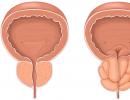Mastopathy fibrocystic is treated with folk remedies
Mastopathy of the mammary glands, or as this disease is also called the official definition of fibrocystic mastopathy, is a benign disease characterized by a pathological change in the histological structure of tissues. More than 30 types of mastopathy (fibrocystic) with various manifestations are known. Cysts and seals are formed at the sites of changes in breast tissue.
Calendula - one of the folk remedies for the treatment of mastopathy
The disease occurs in women and girls of reproductive age from 25 to 45 years. After the risk of developing mastopathy is markedly reduced. Fibrocystic mastopathy occurs in 40-70% of women, but under the influence of various gynecological diseases, the percentage increases significantly.
Types of mastopathy of the mammary glands
Varieties of fibrocystic mastopathy are distinguished by the types of formations in the female breast:
- cystic, accompanied by the formation of cystic seals;
- fibrous, characterized by pathological hyperplasia of the connective tissue;
- nodular, in which glandular and fibrous tissues grow only in certain areas of the mammary gland;
- diffuse fibrocystic, which is characterized by a large number of seals.

Fibrocystic mastopathy: on the right in the figure is a healthy mammary gland, on the left - affected by the disease
Causes of fibrocystic mastopathy
The appearance of nodular or fibrocystic mastopathy is preceded by hormonal imbalance, especially during the last 2 years or more. Prerequisites for the formation of seals are:
- puberty at an early age;
- early menopause;
- menstrual dysfunction;
- diseases of the endocrine system;
- endometriosis;
- anovulatory cycles and infertility against their background;
- ovarian cysts;
- constant severe stress;
- frequent abortions;
- late menopause;
- liver disease;
- sexual life is absent or irregular;
- improper intake of hormonal drugs;
- uterine fibroids;
- diabetes mellitus, obesity;
- endometriosis;
- lack of a lactation period or its short period;
- heredity;
- no pregnancy in the patient's history.
As a rule, the cause of hormonal failure, and as a result of the occurrence of cystic fibrous mastopathy, is excessive production of estrogen and a lack of progesterone. Confirmation of this statement is the fact that women taking combined oral contraceptives are less likely to experience mastopathy. Also, postmenopausal women who do not have hyperestrogenism, mastopathy is not observed.
An excess of prolactin in a woman's body can provoke the appearance of bilateral diffuse fibrocystic mastopathy.

Diabetes is a risk factor for mastopathy
Symptoms of mastopathy
To quickly transgress to treatment, it is necessary to study the symptoms of the disease. The most common manifestation of fibrocystic mastopathy is formations that are well felt on palpation. Before menstruation and in the second half of the cycle, seals become painful. When affected by diffuse mastopathy, single or massive neoplasms are observed in the upper part of the mammary gland.
Main symptoms:
- an increase in the size of the glands;
- soreness radiating to the armpit and shoulder;
- discharge from the milk ducts from clear to bloody, or with a greenish tint;
- enlarged lymph nodes in the armpits;
- exacerbation of symptoms in the premenstrual period.
Despite the fact that the main symptom of the formation of breast cysts is pain, approximately 15% of patients do not experience discomfort. This is related to the threshold of sensitivity.
In the very early stages, the symptoms of mastopathy may not reveal themselves: seals are not felt on palpation, there is no pain or discharge.
To prevent the disease and quickly eliminate it, it is important to undergo examinations by a mammologist every six months.

With mastopathy, pain in the mammary glands increases before menstruation
Diagnosis of mastopathy
If symptoms of the disease begin to appear, you should consult a doctor, and not delay visiting the clinic. You can first conduct an independent examination through palpation, but the lack of experience will not give great results.
The diagnosing physician will conduct an examination. Find out when the first symptoms appeared and the first seals formed. To do this, the patient's history is studied, palpation of the breast, armpits and the area under the collarbones is performed. In addition, an ultrasound examination is performed, mammography is done, if necessary, colposcopy and the cytology of vaginal epithelial cells is studied to study the hormonal background. They also prescribe an examination of the thyroid gland, adrenal glands, and liver.
Treatment with folk remedies
The main treatment is to normalize the hormonal background. Prescriptions for drugs and treatments are written based on what the symptoms are and according to the results of the examination. Sometimes surgery (surgery) and hormone therapy are prescribed.
Those who do not trust hormonal drugs and who have fibrous mastopathy are not accompanied by complications have a chance to get by with folk remedies to cure a dangerous disease.
Medicinal herbs and oils are prescribed depending on the manifestations of violations in the work of the mammary gland and related ailments. To begin with, consider the recipes for decoctions and herbal tea.

Herbal teas and decoctions are a pleasant method of treating mastopathy
Folk remedies. Recipes
Healing herbs will not be able to cure breast diseases in a couple of doses. It takes a long time to use folk remedies and, preferably, comprehensively. The first collection on the path of treatment:
- calendula;
- yarrow;
- nettle leaves.
Each herb is taken in 100 g. Pour 12 tablespoons of the mixture with 500 g of boiling water and insist for 20-30 minutes. Per day you need to consume from 1 liter to 1.5 liters of warm infusion. It is better to stretch the reception for the whole day, drinking half a glass every half an hour. After 15 days, the dose is reduced to 250 g per day. Drink herbs for 3 months with interruptions until complete recovery.
herbal tea
Dried sage allows not only to cure, but to maintain the condition of the glands in order. 1 tsp herbs are poured into 500 g of boiling water and incubated for 10 minutes. For flavor add a leaf of mint or St. John's wort. Drink warm strained infusion in small sips 30 minutes before meals. The admission period is unlimited.

Dry the sage before drinking it as a tea.
Hormonal fees
Herbs rich in phytoestrogens should be used wisely. It is important to take into account the phases of the menstrual cycle and the dominant hormone in the body. Not all folk remedies are suitable for reception in a given period. Example recipes:
- Cycle day 1 to 5. Used for scanty periods. On other days, the use of the herb is not recommended. If you have heavy menstrual bleeding, you can not drink wormwood, it will increase them.
- Cycle day from 6 to 15. Sage infusion is brewed and drunk in the first phase of the cycle, before ovulation.
- Cycle day from 16 to 25. Take a decoction of the uterus of the boron or the root of the red brush. 1 tsp dry grass is steamed in 250 g of boiling water. Drink twice a day, 100 g 20 minutes before meals.
The course of herbal treatment lasts three months. Then they take a break of 2-3 weeks and, if necessary, start again.
Our distant ancestors began to treat women's ailments with this plant. Only the root is used, which contains the anti-inflammatory and anti-carcinogenic substance salidroside. The red brush has a beneficial effect on estrogen metabolism, progesterone production, restores the balance of hormones and the function of the endocrine system. In addition, active substances have a positive effect on increasing immunity, strengthens the cardiovascular system, and detoxifies the body. As you understand, the plant not only eliminates the symptoms, but solves the main problem with hormones.
Take a decoction to treat amenorrhea, dysmenorrhea, PMS, infertility, inflammation of the appendages, cervical erosion and tumors.
For a complete recovery, it is required to undergo at least two courses of herbal medicine.

Red brush - an ancient remedy for female diseases
It is good to treat fibrocystic mastopathy with a cat's claw plant. It has antioxidant properties that affect the treatment of benign and malignant tumors. Removes free radicals and reduces the size of tumors and cysts of the mammary glands. It is recommended to use in combination with medicinal oils and herbal tea.
Recipes for taking cat's claw are simple:
- 250 g of boiling water take 1 teaspoon of dry grass;
- boil in a water bath for 20 minutes and allow to cool;
- strain the broth and add boiled water to the original volume;
- drink a glass a day half an hour before meals.
The course of treatment is 3 months. Then they take a break. You need to complete 2-4 courses.

Cat's claw is a good prevention of neoplasms
Healing oils and lotions
Folk remedies that are used to treat mastopathy are not limited to herbal collections.
apricot kernels
Take the core of the bones for 5-8 pieces per day. Vitamin B17 (amygdalin) is used to treat cancer. This method of treatment is also classified as treatment with folk remedies. That is, without the use of drugs and chemicals.
Linseed oil
Folk remedies used to treat mastopathy include plants with mandatory phytohormones in the composition. Linseed oil beats all records.
Drink it 1 teaspoon before meals or 1-2 tablespoons of ground seeds per day.
Take on an empty stomach 1 tablespoon twice a day. You need to drink slowly. The course of treatment is at least 3 months every half a year. This method of treatment also promotes folk remedies, since it does not use medications.

Elderberry juice is drunk little by little, twice a day.
calendula compress
In 500 ml of boiling water, brew 1 tablespoon of calendula and leave for 30 minutes. In the infusion, moisten gauze or a thin linen towel and apply to the gland. The compress is wrapped with a film and a warm scarf. Keep all night.
It is necessary to treat the mammary glands in a complex way, combining with the intake of infusions and medicinal oils. Folk remedies are also recommended to be combined with a well-chosen diet. After each menstruation and course of treatment, conduct a self-examination. Visit a mammologist every half a year.






